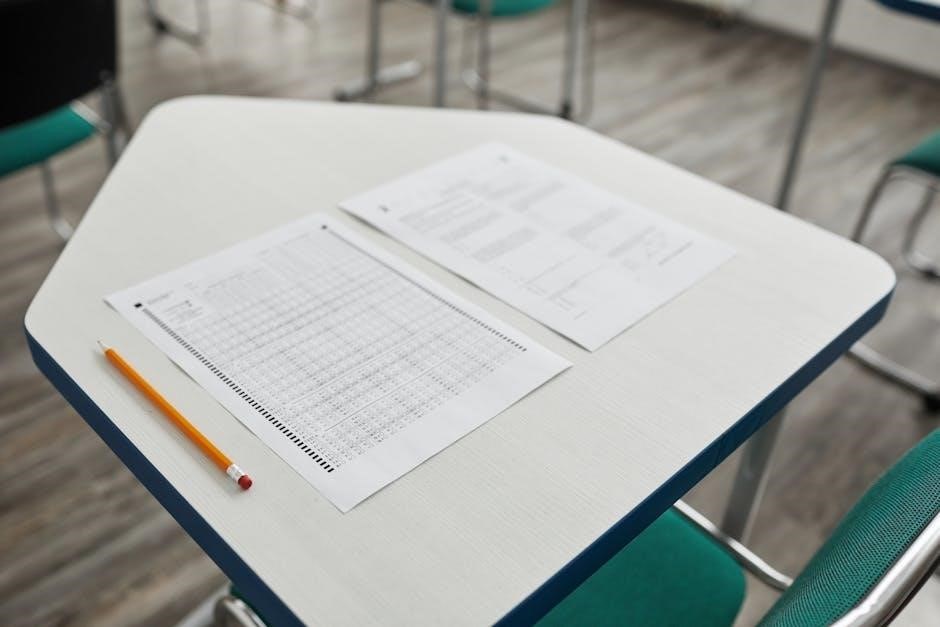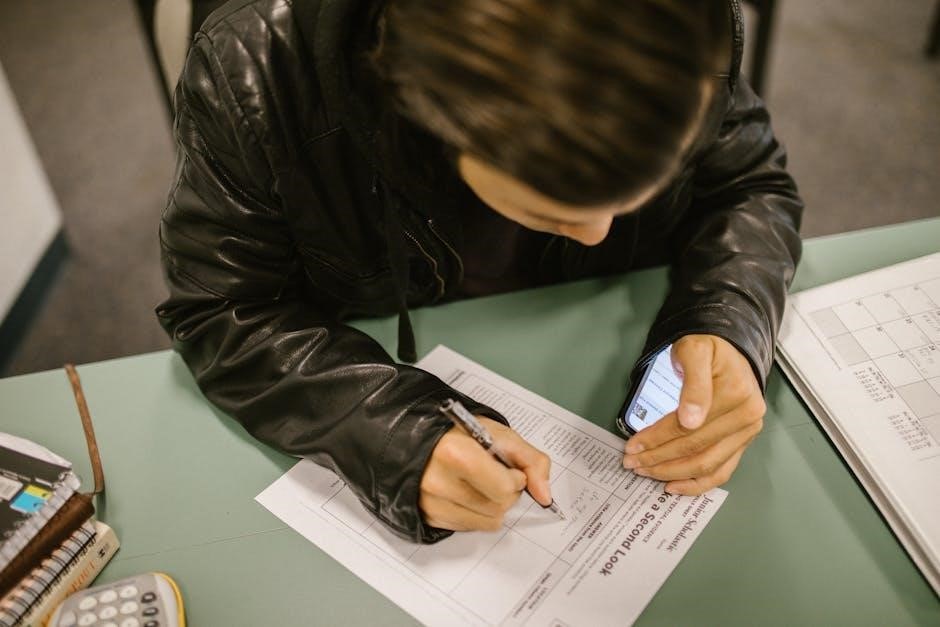Year 10 Maths Test Papers with Answers PDF: A Comprehensive Guide (2025/2026)
Navigating Year 10 maths requires focused preparation. Accessing past papers in PDF format‚ including those from 2025 exams (CBSE & ICSE)‚ is crucial for success;
These resources‚ often available online‚ help students understand exam structures‚ practice problem-solving‚ and build confidence.
Specifically‚ the CBSE Class 10 Mathematics exam for 2026 is scheduled for February 17th‚ emphasizing the need for early preparation.

Understanding the Current Exam Landscape (2025)
The 2025 exam landscape for Year 10 Maths is characterized by a return to more traditional testing methods‚ following adjustments made during recent years. Both CBSE and ICSE boards have released schedules‚ with the CBSE exams commencing February 15th and concluding March 13th.
This year‚ over 39 lakh students are participating in CBSE Class 10 and 12 exams. The ICSE Class 10 Maths exam was held on March 4th‚ 2025‚ signaling a return to a standard examination format.
Effective preparation hinges on utilizing past papers. These provide insight into the types of questions asked‚ the marking schemes employed‚ and the overall difficulty level expected. Accessing these resources in PDF format allows for convenient and focused revision‚ mirroring the actual exam experience.
CBSE Class 10 Maths Exam Schedule 2025 & 2026
The CBSE Class 10 Maths exam schedule reveals key dates for preparation. In 2025‚ the board exams began on February 15th‚ with the Mathematics exam taking place before the March 13th conclusion.
Looking ahead to 2026‚ the Mathematics Standard paper is scheduled for February 17th. This paper is a three-hour assessment worth 80 marks‚ structured with MCQs‚ short answer‚ and long answer questions.
Utilizing past papers from both years is vital. PDF versions of previous question papers allow students to familiarize themselves with the exam format and time constraints. Consistent practice with these resources‚ alongside understanding the schedule‚ will significantly enhance performance and reduce exam-related anxiety.
ICSE Class 10 Maths Exam Information (2025)
The ICSE Class 10 Maths Exam in 2025 was held on March 4th‚ commencing at 11:00 AM. Successful preparation relies heavily on consistent practice with previous years’ question papers.
Accessing these papers in PDF format provides a convenient and cost-effective method for students to understand the exam’s structure and difficulty level. Focusing on solved papers allows for a deeper understanding of marking schemes and expected answer formats.
Effective use of these resources is paramount. Students should analyze their performance on past papers‚ identifying areas needing improvement. Regularly reviewing these PDFs‚ alongside current syllabus topics‚ will build confidence and optimize exam readiness for future assessments.
The Importance of Past Papers for Exam Preparation
Past papers‚ readily available as PDFs‚ are invaluable tools for Year 10 maths exam preparation. They offer authentic insights into the exam pattern‚ question types‚ and marking schemes used by both CBSE and ICSE boards.
Practicing with these papers isn’t simply about memorizing solutions; it’s about developing problem-solving skills and time management strategies. Analyzing previous papers reveals frequently tested topics‚ allowing students to prioritize their revision effectively.
Understanding the exam’s demands is crucial. By working through solved papers‚ students can identify their weaknesses and focus on improving those areas. This targeted approach‚ combined with consistent practice‚ significantly boosts confidence and maximizes potential for success.
Key Exam Components: Structure and Marking Schemes
Year 10 maths exams‚ like the CBSE Class 10 Mathematics paper‚ typically comprise five distinct sections. These include Multiple Choice Questions (MCQs)‚ short answer questions‚ and long answer questions‚ each contributing to the overall 80-mark assessment.

Past papers in PDF format clearly illustrate this structure‚ allowing students to familiarize themselves with the weighting of each section. Understanding the marking schemes is equally vital; knowing how marks are allocated for different steps in a solution is key to maximizing scores.
Effective preparation involves mastering all components. Focusing on both computational accuracy and clear‚ concise explanations‚ as demonstrated in solved past papers‚ is essential for achieving a strong result.
Exam Duration and Total Marks
Most Year 10 maths examinations‚ particularly those aligned with CBSE and ICSE boards‚ adhere to a standard duration of three hours. This timeframe applies to papers like the Mathematics Standard paper‚ designed to assess a broad range of mathematical concepts.
The total marks allocated typically amount to 80‚ serving as the basis for grading and performance evaluation. Analyzing past papers in PDF format reveals consistent adherence to this duration and marking scheme.
Students should practice completing full papers within the allotted time to build exam stamina and time management skills. Familiarity with the total marks also helps prioritize questions based on their weightage‚ optimizing scoring potential.
Section Breakdown: MCQs‚ Short & Long Answer Questions
Year 10 maths exam papers‚ as evidenced by available PDF resources‚ generally comprise a structured format encompassing multiple choice questions (MCQs)‚ short answer questions‚ and long answer questions. The CBSE Mathematics Standard paper specifically includes these sections.
MCQs test foundational understanding and quick recall‚ while short answer questions require concise application of concepts. Long answer questions demand detailed explanations‚ problem-solving strategies‚ and mathematical reasoning.
Past papers reveal varying weightages for each section; therefore‚ students should prioritize practice based on these distributions. Mastering all three question types is crucial for maximizing scores and demonstrating comprehensive mathematical proficiency.
Accessing Year 10 Maths Test Papers with Answers (PDF)
Obtaining Year 10 maths test papers in PDF format is vital for effective exam preparation. Numerous online resources offer these materials‚ facilitating convenient access for students. Websites dedicated to educational resources frequently host past papers from various exam boards‚ including CBSE and ICSE.
Official exam board websites (CBSE‚ ICSE) are primary sources‚ providing authentic papers and marking schemes. Additionally‚ educational platforms and tutoring services often compile and distribute past papers as part of their study materials.
Students should prioritize downloading PDF versions for easy printing and offline access‚ enabling focused practice without internet dependency. Careful selection of reliable sources ensures the authenticity and relevance of the papers.
Where to Find Free PDF Resources Online
Locating free Year 10 maths test papers with answers in PDF format requires strategic online searching. Several websites specialize in providing educational resources without charge. Many tutoring websites offer sample papers or limited access to their full collections as a promotional tool.
Educational forums and online communities often share past papers amongst students. However‚ verifying the authenticity and currency of these resources is crucial. Search engines using specific keywords like “Year 10 maths past papers PDF free download” can yield relevant results.
Remember to exercise caution when downloading files from unfamiliar sources to protect your device from potential malware. Prioritize reputable educational platforms for reliable access.
Reliable Websites Offering Past Papers
Several established platforms consistently provide trustworthy Year 10 maths past papers in PDF format. Official exam board websites – CBSE and ICSE – are the most reliable sources‚ offering authentic papers directly from the examiners. These often include marking schemes for self-assessment.
Reputable educational websites like Physics & Maths Tutor and Maths Genie curate extensive collections of past papers from various exam boards‚ including GCSE which often aligns with Year 10 content.
Always prioritize websites with clear copyright information and a commitment to providing accurate resources. Be wary of sites offering suspiciously large collections or requiring excessive personal information for access.
Utilizing Official Exam Board Websites (CBSE‚ ICSE)
Directly accessing the CBSE and ICSE websites is paramount for authentic Year 10 maths past papers. The CBSE released its 2025 exam schedule on February 15th‚ making prior year papers invaluable for familiarization. ICSE conducted its 2025 Maths exam on March 4th; reviewing that paper provides immediate insight.
These official sources guarantee papers reflect the current syllabus and exam format. Look for dedicated sections for ‘Previous Years’ Question Papers’ or ‘Sample Papers’.
Crucially‚ official websites often provide detailed marking schemes‚ enabling students to understand the examiners’ expectations and refine their answering techniques. Download and utilize these resources for optimal preparation.
Focusing on Higher Tier GCSE Maths Papers
For ambitious Year 10 students‚ utilizing Higher Tier GCSE Maths papers is a strategic advantage. These papers present a greater challenge‚ mirroring the complexity of advanced concepts and problem-solving skills. A Year 10 Higher Tier GCSE paper‚ lasting one hour with a maximum mark of 54‚ is a good starting point.
Focus on non-calculator and calculator papers separately. Non-calculator papers emphasize fundamental skills and algebraic manipulation‚ while calculator papers assess efficient technology use.
Practicing both types builds a well-rounded skillset. Remember to always include units with your answers‚ a common oversight leading to mark deductions.
Non-Calculator Papers: Practice and Strategies

Mastering non-calculator papers demands a strong foundation in core mathematical principles. Consistent practice with Year 10 maths test papers (PDF format is ideal for accessibility) is paramount. Focus on simplifying expressions‚ manipulating formulas‚ and accurate arithmetic without reliance on technology.
Key strategies include showing all working‚ as partial credit is often awarded‚ and carefully checking answers for errors. Prioritize topics like algebraic equations‚ geometry fundamentals‚ and basic trigonometry.
Time management is crucial; allocate sufficient time to each question. Remember‚ these papers test conceptual understanding and procedural fluency‚ not just computational speed.

Calculator Papers: Effective Use of Technology

Calculator papers in Year 10 maths assess your ability to apply mathematical concepts using technology efficiently. Utilizing past papers (available as PDF downloads) is vital for familiarizing yourself with the exam format and appropriate calculator functions.
Focus on mastering complex calculations‚ statistical analysis‚ and graphing techniques. However‚ remember the calculator is a tool‚ not a replacement for understanding the underlying principles. Always double-check inputs and outputs for accuracy.
Practice using your calculator to solve problems from previous test papers‚ paying attention to time management; Knowing when and how to leverage technology effectively can significantly boost your score.
Specific Topics Frequently Tested in Year 10 Maths

Year 10 maths test papers consistently focus on core areas. Analyzing past papers (often found as PDF resources) reveals recurring themes. Algebraic equations and inequalities are heavily featured‚ demanding proficiency in solving for unknowns and understanding solution sets.
Geometry and trigonometry also appear frequently‚ testing your knowledge of shapes‚ angles‚ and trigonometric ratios. Expect questions involving area‚ volume‚ and coordinate geometry. Statistics and probability are crucial‚ requiring data interpretation and calculation of probabilities.

Consistent practice with these topics‚ using available test papers‚ will build confidence and improve exam performance. Focus on mastering fundamental concepts and applying them to varied problem types.
Algebraic Equations and Inequalities
Mastering algebraic equations and inequalities is vital for Year 10 success. Past papers (available in PDF format) consistently test skills in solving linear‚ quadratic‚ and simultaneous equations. Expect questions requiring factorization‚ expansion‚ and rearrangement of formulas.
Inequalities are also prominent‚ demanding understanding of solution sets and representation on number lines. Practice manipulating inequalities‚ remembering to reverse the inequality sign when multiplying or dividing by a negative number.
Utilizing solved examples from test papers helps solidify understanding. Focus on applying these skills to real-world problems‚ as exam questions often involve contextual scenarios. Consistent practice builds fluency and accuracy.
Geometry and Trigonometry
Geometry and trigonometry form a significant portion of Year 10 maths assessments. Past papers (in PDF format) frequently feature questions on angle properties‚ triangle congruence‚ and similarity. Expect problems involving area‚ perimeter‚ and volume calculations for 2D and 3D shapes.
Trigonometry is crucial‚ demanding proficiency in SOH CAH TOA‚ the sine rule‚ and cosine rule. Practice applying these to solve problems involving right-angled and non-right-angled triangles. Understanding bearings and angles of elevation/depression is also key.
Reviewing worked solutions from previous test papers clarifies problem-solving techniques. Focus on accurate diagram interpretation and precise application of trigonometric ratios.
Statistics and Probability
Statistics and probability are consistently tested in Year 10 maths exams. Accessing past papers (PDFs) provides invaluable practice with data interpretation‚ mean‚ median‚ mode‚ and range calculations. Expect questions involving frequency tables‚ histograms‚ and pie charts.
Probability questions often involve calculating the likelihood of events‚ using concepts like independent and dependent events. Understanding sample space and theoretical vs. experimental probability is vital. Practice with tree diagrams and Venn diagrams is highly recommended.
Analyzing worked solutions from previous papers demonstrates effective data handling and probability calculation techniques. Pay close attention to accurate representation and interpretation of statistical data.

Exam Techniques for Maximizing Your Score
Utilizing past papers (PDF format) is key to mastering exam technique. Practice under timed conditions to improve speed and accuracy. Prioritize questions based on marks and your confidence level – tackle easier questions first to secure quick wins.

Time management is crucial. Allocate specific time slots for each section and stick to them. Show all your working clearly‚ even for seemingly simple calculations‚ to potentially gain partial credit.
Review past paper solutions to identify common mistakes and refine your approach. Carefully read each question to understand exactly what is being asked‚ avoiding careless errors. Double-check your answers before submitting the paper.
Time Management During the Exam
Effective time management is paramount for success. Begin by quickly scanning the entire paper to assess its length and difficulty. Allocate time to each question based on its mark weighting – higher marks demand more time.
Prioritize questions you’re confident with. Answering these first builds momentum and secures easy marks. If stuck on a question‚ don’t dwell; move on and return to it later if time permits.
Utilize past papers (PDFs) during practice to simulate exam conditions and refine your timing. Regularly check the clock to stay on track. Leave sufficient time at the end to review your answers and check for careless errors.
Answering Strategies and Common Mistakes to Avoid
Employ clear and concise working. Show all steps‚ even for seemingly simple calculations‚ to maximize partial credit. Utilize diagrams and labeled sketches where appropriate‚ especially in geometry and trigonometry questions.
Pay close attention to units. Failing to include correct units is a frequent error. Double-check your answers against the question’s requirements. Avoid rounding intermediate calculations‚ as this can lead to inaccuracies in the final answer.
Reviewing past papers (PDFs) reveals common mistakes. Practice identifying and correcting these errors. Carefully read each question to understand exactly what is being asked. Don’t assume; address the specific problem presented.
Effective preparation hinges on utilizing available resources. Year 10 maths test papers with answers‚ readily available in PDF format‚ are invaluable tools for students aiming for success in 2025/2026. These papers mirror the structure and difficulty of actual exams‚ allowing for realistic practice.
Focus on both CBSE and ICSE past papers. The CBSE schedule indicates exams starting February 15th‚ 2025‚ with the Class 10 Mathematics exam slated for February 17th‚ 2026.
Analyzing solved papers helps identify weak areas and refine problem-solving techniques; Consistent practice builds confidence and improves time management skills‚ crucial for exam performance.